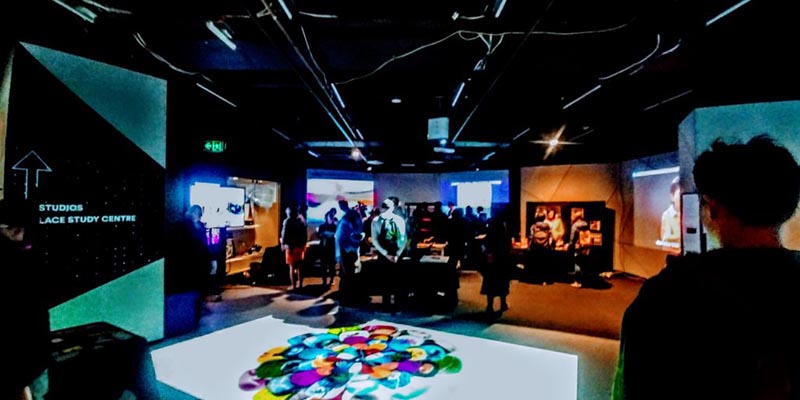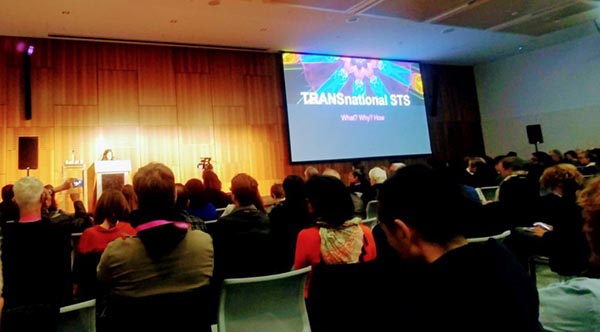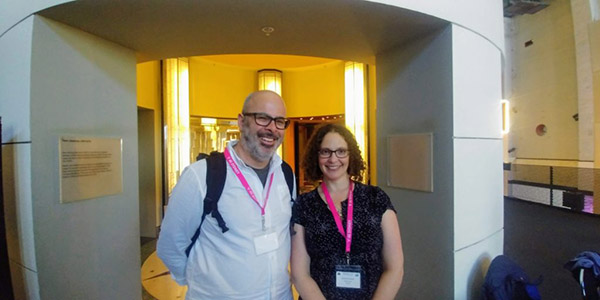The 2018 meeting of the Society for the Social Studies of Science (4S), was held from August 29th to September 1st, (mostly) in the International Conference Center (ICC) in Sydney, Australia, and was dedicated to the theme of TRANSnational STS. As Kim Fortun, the current president of the society, asked: What, How and Why TRANS? This four-day event, itself made of so many sub-events, was convened for in the Southern Hemisphere for the second time ever (the first was Buenos Aires back in 2014); it was also the second time the meeting was held in the Asia-Pacific Region (after Tokyo, in 2010).
As its theme and location demonstrate, the annual 4S conference and the organizing society itself have been undergoing a transformation to include a more global community. Nevertheless, this does not necessarily mean that STS itself is becoming globalized. As 4S 2018 revealed, this international expansion is part of a process to recognize several flavors of inquiry that have been historically underrepresented in the community, expanding our intellectual tastes as STS scholars.

Making and Doing experience. Powerhouse Museum. Aug 29th, 2018. Photo by the author.
The inaugural day of the conference began with a panel discussion on STS publishing. Panelists celebrated the 2018 4S Infrastructure Prize, awarded to East Asian Science, Technology and Society: An International Journal (EASTS). The discussion highlighted the value of regional and topical diversity in the field, current challenges for open-access scholarly publishing and the need to “un-black box” editorial practices. In addition, the conference featured previous experiments in this area. The “Making & Doing” session was the main event of the day, held at the Powerhouse Museum of Applied Arts and Sciences. The museum was the perfect venue, reflecting the spirit of a session that acknowledged engagement and creativity outside of research papers. I felt that the nature of the event was well-suited to the spirit of the place, exposing the TRANS-disciplinary practices inherent in our field—practices that transcend printed ideas. In the evening, two plenaries continued the spirit of the event. A round-table discussion about “regional STS” and Kim Fortun’s Presidential Plenary both acknowledged multiplicity and history as focal points to frame this Australian experience.

Kim Fortun’s Presidential Plenary. Photo by the author.
On the second day, on a walk around ICC, I encountered 26 parallel sessions, held from 9 to 5:30. The organization and program teams did an impressive job grouping and distributing so many papers–approximately 1100 in total! I think it is relevant that both teams were nationally and internationally diverse, with the strong presence of women. For me, these influences were felt in the experience, in the configuration of the days, and in the activities, and venues. These also created a more inclusive conference, making the trip to Australia feel very worthwhile. That night, a parallel event was the keynote for this conference. Helen Verran’s Dyason lecture, held in New South Wales’ library, was completely packed. In her talk, she invited us to reflect on knowledge spaces with strangers, using the inauguration of STS perspectives in Australia as an example. At the same time, she illustrated the complexities of acknowledging all tastes in her audience (dar en el gusto todos, in Spanish). The conversation about standpoints in the visual analysis, incomplete and complementary stories and grounding practices in the field, was rich and quite compelling.

The participants in the “Innovation in Theory and Methods” Panel. ICC 2nd Floor. Aug 31st, 2018. Photo by the author.
Friday also had an interesting structure, with parallel sessions held only in the morning. The panel in which I participated, on “Innovation in Theories and Methodologies,” provided excellent food for thought on STS research. The moderator, Colin Agur created an excellent balance between an eclectic collection of topics, incorporating them all in the conversation (and inspiring us to think a little about next year’s focus on innovations). In the afternoon, the focus turned to a current, enduring topic in Australian STS: non-Western epistemologies. The Indigenous Plenary, moderated by Timothy Neale, allowed us to expand our perspectives beyond traditional knowledge systems. In a careful conversation, the participants revealed their experiences in life and research about indigenous communities in an intimate and challenging discussion unprecedented in a plenary. That evening the last plenary event, “Prizes and Futures,” honored the changes in 4S over time, excellence in several areas in our field and included some reflections on what it means to be an international society. Kim Fortun shared a report, made by a team coordinated by Anita Say Chan, which gives a public account of “other forms” of scientific societies, with a particular focus on how research societies can be funded and how to give care to local projects supported by 4S.
The last day was also full of parallel sessions. Topics from ranging from public engagement to the development and artificial intelligence were distributed throughout the day. Two moments stood out to me: first, an open conversation reflecting on national scholarly organizations, moderated by Kim Fortun, in which the experiences of academics in at least 25 countries and regions (from Taiwan and Austria to Canada and Ecuador) demonstrated the breadth of what it means to do Science and Technology Studies. The second was the “Across Borders Wrap-up.” From Thursday to Saturday, analog and digital archives from 20 collections shared in a new format for this year’s conference. Aalok Khandekar led a team to launch this format to record and explore the stories of different STS communities globally. These collections, which are still available to be explored in STS Infrastructures, were an opportunity for researchers to explore the many kinds of STS found worldwide. For example, the STS Turkey exhibit was centred around the past and history of Turkish STS, while also presenting new initiatives in their community within an archive format.

Across Borders practice, curated by Aalok Kardenkar. ICC 5th Floor, Aug 31, 2018. Photo by the author.
Anthropologists tend to describe their epistemic history through “turns,” but after 4S Sydney I’m convinced that STS community has “flavors.” Sitting at the same table, a multiplicity of researchers, practitioners, and critical thinkers shared a never-ending banquet of ideas, in a commonality of perspectives, engaging with unexpected institutional, political and academic practices to unfold wicked knowledge problems (and sometimes, move beyond them). This relates to the history of the natural philosophers Johan Blumenbash, who imagined the platypus, Ornithorhynchus paradoxus as a chimera. I’m curious: How does a Platypus taste? Probably similar to STS.
Australia gives the opportunity for intrepid omnivores to taste kangaroo, crocodile, and other animals, but not the endangered platypus (for good reason!). I wanted to speculate about the range of flavours in each part. It would probably be as the first natural philosophers imagined—a mix of all of the animal parts that they recognized. In my opinion, the TRANS-national framing was a definitive step in the 4S story for crystallizing a global identity, and to share those rare research outside the current (Western, white and male) STS cannon. There is a range of invisible research, that goes beyond social science epistemologies, incorporating the politics of design, libraries, geography among others, in our emerging “STS tradition”.
As the 4S conference evolves, with new formats, journals, and places emerging in the past 5 years. I imagine future conferences will offer even more of these uncommon (or non-Western) authors, topics and practices to connect. From a personal intellectual standpoint, this conference was an invitation to experience the “Platypus Complex” that is STS. Not simply a sum of the parts, but a complete and unique species that is full of flavors to acknowledge and recognize. This is a big challenge, but luckily the next step is to innovate.

The co-chairs at the Making and Doing event. Powerhouse Museum. Aug 29th, 2018. Photo by the author.
